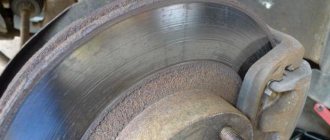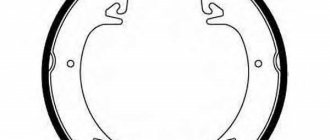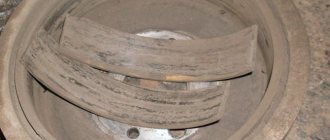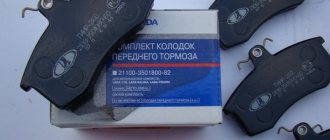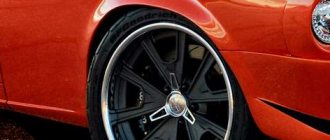Replacing front brake pads in Lada Kalina
The choice of front brake pads should be treated carefully, since the spare parts market is saturated with low-quality and counterfeit goods. Thus, it is necessary to check the presence of holograms and branded packaging. Inside the box there is always an instruction manual that states who made it and the composition of the friction part.
So, let's look at what front pads are best to use on the Lada Kalina.
Original spare parts
Let's start with the original part from AvtoVAZ. The catalog number of the part by which the search is performed looks like this - 2110-3501080. These are the same pads that are installed on the VAZ 2110 and Priora. The factory decided not to change the structure of the front brakes. Their cost is 400 rubles per set.
Analogs
Now, let's look at possible analogues that can be installed instead of the original brake pads on the Lada Kalina.
Based on the experience of motorists and the recommendations of experts, there are several manufacturers that deserve special attention. They make high-quality pads, and their service life, as practice shows, is 30,000 km.
Tuning kits
It is worth considering an alternative option for choosing pads - tuning. Only a few manufacturers produce spare parts for Kalina, which do not require alteration of the chassis. The most famous are: Brembo, Delphi and Feredo. The pads are mounted on standard seats.
For lovers of complete tuning, it offers a complete set of brake systems, which includes: brake discs, calipers and pads. Of course, for full efficiency, it is worth installing everything in one set.
One of the first things that it is advisable to do after purchasing a Lada Kalina is replacing the front brake pads. And the sooner the better, since standard ones installed at the factory wear out the brake disc a lot.
To work we need the following tool:
- Jack;
- Balloon wrench;
- Flat head screwdriver;
- Pliers;
- Open-end wrench 17;
- Socket or open-end wrench 13;
- A pipe clamp or barb (preferably, but not required);
- A couple of bricks)).
Time to complete all operations for replacing pads: from 30 minutes.
At the plant, “TIIR” pads are installed on Lada Kalina.
I chose Lucas TRW pads as they have proven themselves among car enthusiasts.
Let's start replacing the pads on the left wheel.
While the wheel is on the ground, loosen the four bolts, otherwise in a suspended state, when you try to unscrew the bolts, the wheel will rotate.
DETAILS: How to clean the stove radiator without removing it? Cleaning, washing
Do not press the brake pedal while performing work!
Considering that new pads are thicker than worn ones, when replacing the brake system, fluid will be forced out of the brake system into the storage tank, therefore, if the brake fluid level is at the MAX mark and if the old pads are pretty worn out, it is necessary to temporarily remove some of the fluid using syringe.
Before lifting the left front wheel with a jack, you need to place two bricks under the rear right wheel in order to prevent the machine from rolling away during work and subsequent tipping over from the jack.
The jack must be rested on a special platform “1″ (see photo) or “2″. Pressing in other places may cause damage to the vehicle body.
The photo shows that the disc, even after a short run, has grooves. Rust on the disc is normal.
To raise the caliper, you need to unscrew the bolt “1” with a 13 wrench. Bend the locking plate with a screwdriver and pliers and hold the nut “2” (with a 17 open-end wrench) from turning. Since the pads being removed are a little worn, you need to recess the brake piston (indicated in the photo by a red rectangle).
The hand force may not be enough to press the piston. To do this, you can use a clamp or pipe wrench.
Another option: leave one block on the inside, and insert a large flat-head screwdriver into the place indicated by the red arrow in the photo. We rest the blade of the screwdriver against the non-working part of the brake disc (closer to the axis) and, acting with the screwdriver as a lever, pull the screwdriver handle towards ourselves, thereby moving the caliper towards us relative to the disc and, accordingly, pressing the brake piston.
We install new pads in place of the old ones, lower the caliper, tighten the bolt and bend the safety plate to prevent the bolt from unscrewing spontaneously.
We adjust the steering wheel straight, install the wheel on the guide pins, and fasten the four bolts without tightening them. Lower the jack and tighten the bolts thoroughly.
We repeat the same for the other wheel.
If you drained the brake fluid, fill it back into the reservoir to the “MAX” level.
Brake pads must be changed simultaneously on the left and right sides to prevent uneven braking force on the wheels, which can lead to the car pulling to the side or skidding when braking.
Immediately after installing new pads, before they rub against the disc. braking efficiency decreases sharply, this must be kept in mind while driving!
After installing new brake pads, you need to grind them in during the first 200 km, i.e. If possible, avoid pressing the brake pedal intensively by reducing speed in advance. This is especially important in the first kilometers after replacement.
Service life of Kalina's factory front pads
The rate at which your car's brake pads wear out depends on your driving style and operating conditions.
On the first generation Kalina, the average resource is 40-45 thousand kilometers . Updated versions of consumables were installed on second-generation cars. Under average loads, they wear out only after 60,000 km . However, in some cases replacement is required much earlier.
Which brake pads to choose
About a month ago I wrote a topic in which I shared the problem I had with the front brake pads. The essence of this malfunction was as follows: when braking, even not sharply, a terrible creaking began to appear. Since I changed the linings quite recently, I thought that they were either rusty, since my Kalina practically did not drive in winter, or some kind of pebble hit, which was the source of this sound.
DETAILS: How diesel injectors are diagnosed and repaired
But after looking more closely at the pads and discs, it became clear that there was no rust at all, and no foreign bodies either. Meanwhile, the creaking became stronger and stronger. I decided to remove the front wheel and take a closer look at what was wrong.
Ferodo
After reading a lot of reviews about this brand on the Internet, especially on Drive, I was already thinking about purchasing spare parts from this company. Everyone praised them, both the green and the red packaging, but there were also some owners who were very dissatisfied with these details.
Fake production, such as AvtoVAZ
As you probably already guessed, I drove just 8,000 kilometers on these pads, after which they turned into black dust left on the disks of my Kalina. I remember I picked them up at the car market for a price of about 230 rubles. And as the seller assured me, it was exactly the original from AvtoVAZ, which I, of course, later doubted, because my factory ones went about 30,000 km and weren’t even half worn out, but I’ll tell you why I replaced them a little later.
Factory pads produced by AvtoVAZ
As for the service life, I have no complaints here at all, in this they completely suit me. Judge for yourself, they spent 30 thousand and could have served just as long. But there are huge complaints about the quality of braking; to put it mildly, there was none at all.
I remember there were several cases when it was difficult to avoid a collision in city traffic. While I pressed the brake pedal with all my might, the car continued to float without noticeable slowdown. It was after several such cases that I decided to change it, but as it turned out, I ended up with a fake.
https://www.youtube.com/watch?v=62U49DZ3tw0
DETAILS: Car antenna for car radio, radio
When the above options disappeared for reasons already known to you, I decided to wander through the forums of foreign car owners, and since I am a fan of the Volvo brand, I went to their club and read what kind of pads were on these cars from the factory. And according to many owners, their front and rear brake pads came from the factory from ATE.
Well, I decided that if the safest cars in the world have such brakes, then they would also be an ideal option for Kalina. And now a few words about the impressions after installation. The first few kilometers, of course, there were no special changes, since they were still new and had not gotten used to it, but then everything became just super.
Now, just before the speed bump, I brake and the car stops dead in its tracks, there are no sounds even close. As for efficiency, everything is just perfect here; I have not yet seen better brakes. But I can’t say anything about their service life yet, since I’ve only driven them a little over a thousand kilometers.
And one more plus after installing them - the discs again became perfectly smooth, like new, otherwise they were corrugated from old defective parts, all in grooves. As soon as I drive the first 10,000 km on the ATE, I will definitely write about the results, subscribe and follow the blog updates. Thank you for your attention!
Brake pads Lada Kalina (1117) 1 Station wagon 1.6 84 hp.
Brake pads consist of a friction compound cast and glued or riveted onto a metal backing plate. Friction material wears out naturally and the pads must be replaced periodically. There are many formulas for producing friction materials such as organic, semi-metallic or ceramic with unique characteristics. When it comes to brake pads, there is always a choice between standard and premium ones.
Standard brake pads Lada Kalina (1117) 1 Station wagon 1.6 84 hp. Best suited for normal driving conditions such as city driving, daily commuting or highway driving. Generally, stock brake pads are the most commonly used OE brake pads, are the least toxic to the earth, and are the softest for all types of braking systems. These pads provide low noise levels during operation, as well as extremely low wear on the brake discs. Advantages of standard brake pads:
- simple and reliable braking
- smoother, quieter braking
- uniform wear throughout the entire service life
- good quality and low price
Premium brake pads provide superior braking performance and reliability for cars and trucks. All premium brakes are engineered to extend life and maintain high levels of friction at all operating temperatures and often feature OE type gas sipes and chamfers to optimize braking performance in emergency situations or on the track.
It is customary to classify brake pads into three types:
- Organic brake pads are made from organic fiber. Organic pads generally do not wear down the brake rotor and provide quiet operation, but they wear out faster than other types and do not perform well in high temperatures.
- Semi-metallic brake pads - contain a mixture of steel, iron, copper and other inorganic fibers. They provide high temperature performance and wear resistance, but cause increased noise, brake disc wear and brake dust.
- Ceramic brake pads are organic, but contain ceramic and copper fibers that allow them to perform well at high temperatures, with less wear, virtually silently and without causing disc wear or brake dust.
The choice between these characteristics is a choice between the efficiency and cost of brake pads Lada (VAZ) Kalina (1117) 1 Station wagon 1.6 84 hp. . Regardless of your choice, our specialists will help with the selection, check the applicability of the VIN code and recommend a quality manufacturer in any price category.

